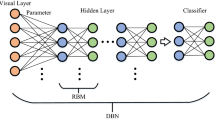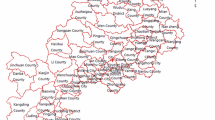Abstract
A dataset of landslides from Sichuan Province in China, containing 1551 historical individual landslides, is a result of two teams’ effort in the past few years to map the susceptibility to landslides. Considering complex internal relations among the triggering factors, logistic regression (LR) and shallow neural networks, such as back-propagation neural network (BPNN), are often limited. In this paper, we make a straightforward development that the deep belief network (DBN) based on deep learning technology is introduced to map the regional susceptibility to landslides. Seven factors with respect to geomorphology, geology and hydrology are considered and verified through the collinearity test. A DBN model containing three pre-trained layers of restricted Boltzmann machines by stochastic gradient descent method is configured to obtain the susceptibility to landslides. Susceptibility results evaluated by DBN model are compared with those by LR and BPNN in the receive operator characteristic (ROC) analysis, showing that DBN has a better prediction precision, with a lower rate of false alarms and fake alarms. The case study also indicates different sensitivities of the triggering factors to the landslide susceptibility, that the factors of altitude, distance to drainage network and average annual rainfall have significant impact in mapping the susceptibility to landslides in the region. This research will contribute to a better-performance model for regional-scale mapping for the susceptibility to landslides, in particular, at the area where triggering factors show complex relations and relative independence.












Similar content being viewed by others
References
Abedini M, Tulabi S (2018) Assessing LNRF, FR, and AHP models in landslide susceptibility mapping index: a comparative study of Nojian watershed in Lorestan Province, Iran. Environ Earth Sci 77(11):405
Aditian A, Kubota T, Shinohara Y (2018) Comparison of gis-based landslide susceptibility models using frequency ratio, logistic regression, and artificial neural network in a tertiary region of Ambon, Indonesia. Geomorphology 318:101–111
Alexander DE (2004) Vulnerability to landslides. In: Glade T et al (eds) Landslide hazard and risk. Wiley, Berlin, pp 175–198
Arora MK, Das Gupta AS, Gupta RP (2004) An artificial neural network approach for landslide hazard zonation in the Bhagirathi (Ganga) Valley, Himalayas. Int J Remote Sens 25(3):559–572
Avtar R, Singh CK, Singh G, Verma RL, Mukherjee M, Sawada H (2011) Landslide susceptibility zonation study using remote sensing and GIS technology in the Ken-Betwa River Link area, India. Bull Eng Geol Env 70(4):595–606
Ballabio C, Sterlacchini S (2012) Support vector machines for landslide susceptibility mapping: the Staffora river basin case study, Italy. Math Geosci 44(1):47–70
Chen W, Xie XS, Wang JL et al (2017) A comparative study of logistic model tree, random forest, and classification and regression tree models for spatial prediction of landslide susceptibility. CATENA 151:147–160
Cheng DQ, Cui YF, Su FH, Jia Y, Choi CE (2018) The characteristics of the Mocoa compound disaster event, Colombia. Landslides 15:1223–1232
Cogan J, Gratchev I, Wang GH (2018) Rainfall-induced shallow landslides caused by ex-Tropical Cyclone Debbie, 31st March 2017. Landslides 15(6):1215–1221
Dalal N, Triggs B, Schmid C (2006) Human detection using oriented histograms of flow and appearance. Springer, Berlin, pp 428–441
Demir G, Aytekin M, Akgün A, Ikizler SB, Tatar O (2013) A comparison of landslide susceptibility mapping of the eastern part of the North Anatolian Fault Zone (Turkey) by likelihood-frequency ratio and analytic hierarchy process methods. Nat Hazards 65:1481–1506
Dormann CF, Elith J, Bacher S et al (2013) Collinearity: a review of methods to deal with it and a simulation study evaluating their performance. Ecography 36(1):27–46
Ghahabi O, Hernando J (2014) Deep belief networks for I-vector based speaker recognition. In: Proceedings of 2014 international conference on acoustics, speech and signal processing. IEEE, Florence, pp 1700–1704
Gorsevski PV, Gessler PE, Foltz RB, Elliot WJ (2006) Spatial prediction of landslide hazard using logistic regression and ROC analysis. Trans GIS 10(3):395–415
Guzzetti F, Carrara A, Cardinali M, Reichenbach P (1999) Landslide hazard evaluation: an aid to a sustainable development. Geomorphology 31:181–216
Han Z, Chen GQ, Li YG et al (2015a) Numerical simulation of debris-flow behavior incorporating a dynamic method for estimating the entrainment. Eng Geol 190:52–64
Han Z, Chen GQ, Li YG et al (2015b) Exploring the velocity distribution of debris flows: an iteration algorithm based approach for complex cross-sections. Geomorphology 241:72–82
Han Z, Chen GQ, Li YG et al (2015c) Assessing entrainment of bed material in a debris-flow event: a theoretical approach incorporating Monte Carlo method. Earth Surf Proc Land 41:1877–1890
Han Z, Li YG, Du YF, Wang WD, Chen GQ (2018a) Noncontact detection of earthquake-induced landslides by an enhanced image binarization method incorporating with Monte-Carlo simulation. Geom Nat Hazards Risks 10(1):219–241
Han Z, Wang WD, Li YG, Huang JL, Chen GQ (2018b) An integrated method for rapid estimation of the valley incision by debris flows. Eng Geol 232:34–45
Han Z, Su B, Li YG, Dou J, Wang WD, Zhao LH (2020) Modeling the progressive entrainment of bed sediment by viscous debris flows using the three-dimensional SC-HBP-SPH method. Water Res. https://doi.org/10.1016/j.watres.2020.116031
Hosseinzadeh M, Servati M, Mansouri A, Mirbagheri B, Khezri S (2009) Landslide hazard zonation using logistic regression, the way Sanandaj-Dehgolan, Iran. J Geol 11:27–37
Kanungo DP, Sarkar S, Sharma S (2011) Combining neural network with fuzzy, certainty factor and likelihood ratio concepts for spatial prediction of landslides. Nat Hazards 59(3):1491
Li YG, Liu XT, Han Z, Dou H (2020a) Spatial proximity-based geographically weighted regression model for landslide susceptibility assessment: a case study of Qingchuan Area, China. Appl Sci 10:1107
Li JY, Wang WD, Han Z, Li YG, Chen GQ (2020b) Exploring the impact of multitemporal DEM data on the susceptibility mapping of landslides. Appl Sci 10:2518
Listo FDLR, Carvalho VB (2012) Mapping of risk and susceptibility of shallow-landslide in the city of Sao Paulo, Brazil. Geomorphology 169–170:30–44
Liu G, He J, Li R et al (2018) Topological and dynamic complexity of rock masses based on GIS and complex networks. Physica A 512:1240–1248
Mao Y, Zhang M, Sun P, Wang G (2017) Landslide susceptibility assessment using uncertain decision tree model in loess areas. Environ Earth Sci 76(22):752
Merghadi A, Abderrahmane B, Tien Bui D (2018) Landslide susceptibility assessment at Mila Basin (Algeria): a comparative assessment of prediction capability of advanced machine learning methods. ISPRS Int J Geoinf 7(7):268
Meten M, Bhandary NP, Yatabe R (2015) GIS-based frequency ratio and logistic regression modelling for landslide susceptibility mapping of Debre Sina area in central Ethiopia. J Mt Sci 12(6):1355–1372
Palamakumbure D, Flentje P, Stirling D (2015) Consideration of optimal pixel resolution in deriving landslide susceptibility zoning within the Sydney Basin, New South Wales, Australia. Comput Geosci 82:13–22
Park I, Lee S (2014) Spatial prediction of landslide susceptibility using a decision tree approach: a case study of the Pyeongchang area, Korea. Int J Remote Sens 35(16):6089–6112
Polykretis C, Chalkias C (2018) Comparison and evaluation of landslide susceptibility maps obtained from weight of evidence, logistic regression, and artificial neural network models. Nat Hazards 93(3):1–26
Polykretis C, Ferentinou M, Chalkias C (2015) A comparative study of landslide susceptibility mapping using landslide susceptibility index and artificial neural networks in the Krios River and Krathis River catchments (northern Peloponnesus, Greece). Bull Eng Geol Env 74(1):27–45
Pradhan B, Sezer EA, Gokceoglu C, Buchroithner MF (2010) Landslide susceptibility mapping by neuro-fuzzy approach in a landslide prone area (Cameron Highland, Malaysia). IEEE Trans Geosci Remote Sens 48(12):4164–4177
Raja NB, Cicek I, Turkoglu N, Aydin O (2017) Landslide susceptibility mapping of the Sera River Basin using logistic regression model. Nat Hazards 85(3):1323–1346
Ramesh V, Anbazhagan S (2015) Landslide susceptibility mapping along Kolli hills Ghat road section (India) using frequency ratio, relative effect and fuzzy logic models. Environ Earth Sci 73:8009–8021
Rioux L, Giguere P (2014) Sign language fingerspelling classification from depth and color images using a deep belief network. In: Proceedings of 2014 Canadian conference on computer and robot vision. IEEE, Quebec, pp 92–97
Sahana M, Sajjad H (2017) Evaluating effectiveness of frequency ratio, fuzzy logic and logistic regression models in assessing landslide susceptibility: a case from Rudraprayag district, India. J Mt Sci 14(11):2150–2172
San BT (2014) An evaluation of SVM using polygon-based random sampling in landslide susceptibility mapping: the Candir catchment area (western Antalya, Turkey). Int J Appl Earth Obs Geoinf 26:399–412
Sdao F, Lioi DS, Pascale S, Caniani D, Mancini M (2013) Landslide susceptibility assessment by using a neuro-fuzzy model: a case study in the Rupestrian heritage rich area of Matera. Nat Hazards Earth Syst Sci 13:395–407
Sezer EA, Pradhan B, Gokceoglu C (2011) Manifestation of an adaptive neuro-fuzzy model on landslide susceptibility mapping: Klang Valley, Malaysia. Expert Syst Appl 38(7):8208–8219
Shao JA, Li YB, Ni JP (2012) The characteristics of temperature variability with terrain, latitude and longitude in Sichuan-Chongqing region. J Geog Sci 22(2):223–244
Shirzadi A, Bui DT, Pham BT et al (2017) Shallow landslide susceptibility assessment using a novel hybrid intelligence approach. Environ Earth Sci 76(2):60
Su C, Wang L, Wang X, Huang Z, Zhang X (2015) Mapping of rainfall-induced landslide susceptibility in Wencheng, China, using support vector machine. Nat Hazards 76:1759–1779
Wang WD, Xie CM, Du XG (2009) Landslides susceptibility mapping based on geographical information system, GuiZhou, south-west China. Environ Geol 58(1):33–43
Wang WD, Guo J, Fang LG, Chang XS (2012) A subjective and objective integrated weighting method for landslides susceptibility mapping based on GIS. Environ Earth Sci 65(6):1705–1714
Wu X, Ren F, Niu R (2014) Landslide susceptibility assessment using object mapping units, decision tree, and support vector machine models in the Three Gorges of China. Environ Earth Sci 71:4724–4738
Xu C, Wu W, Ge Q (2018) Impact assessment of climate change on rice yields using the ORYZA model in the Sichuan Basin, China. Int J Climatol 18:2922–2939
Youssef AM, Pourghasemi HR, El-Haddad BA, Dhahry BK (2016) Landslide susceptibility maps using different probabilistic and bivariate statistical models and comparison of their performance at Wadi Itwad Basin, Asir Region, Saudi Arabia. Bull Eng Geol Environ 75(1):63–87
Zhang L, Guo XM, Zhao TL et al (2019) A modelling study of the terrain effects on haze pollution in the Sichuan Basin. Atmos Environ 196:77–85
Zhu CC, Yin JP, Li Q (2014) A stock decision support system based on DBNs. J Comput Inf Syst 10(2):883–893
Acknowledgements
This study was financially supported by the National Key R&D Program of China (Grant No. 2018YFC1505401, Z. Han); the National Natural Science Foundation of China (Grant No. 51478483, W. Wang; Grant No. 41702310, Z. Han); and the Natural Science Foundation of Hunan (Grant No. 2018JJ3644, Z. Han). These financial supports are gratefully acknowledged. We also extend our gratitude to the editorial office and the nominated reviewer for their insightful comments.
Author information
Authors and Affiliations
Contributions
Prof. W. Wang collected dataset of landslides. Prof. Z. Han designed the study. Z.L. He wrote the manuscript. Prof. Y.G. Li optimized the DBN model. Dr. J. Dou participated in the analysis of the susceptibility results. All authors discussed the results and commented on the manuscript.
Corresponding author
Additional information
Publisher's Note
Springer Nature remains neutral with regard to jurisdictional claims in published maps and institutional affiliations.
Appendix: Weight calculation method
Appendix: Weight calculation method
Each triggering factor contains several secondary categories. The area of all secondary categories \(A_{ij}\) and the corresponding historical landslide area \(a_{ij}\) were obtained with the statistical function of ArcGIS. Then, the area proportion of the categories \(R_{ij}\) and the area proportion of the corresponding historical landslide area \(r_{ij}\) can be calculated:
where m is the number of factor categories. Finally, the dimensionless relative weight of each category \(I_{ij}\) is calculated according to the landslide density of each category \(T_{ij}\):
The weight of each category is recorded in Appendix Table 3.
Rights and permissions
About this article
Cite this article
Wang, W., He, Z., Han, Z. et al. Mapping the susceptibility to landslides based on the deep belief network: a case study in Sichuan Province, China. Nat Hazards 103, 3239–3261 (2020). https://doi.org/10.1007/s11069-020-04128-z
Received:
Accepted:
Published:
Issue Date:
DOI: https://doi.org/10.1007/s11069-020-04128-z




